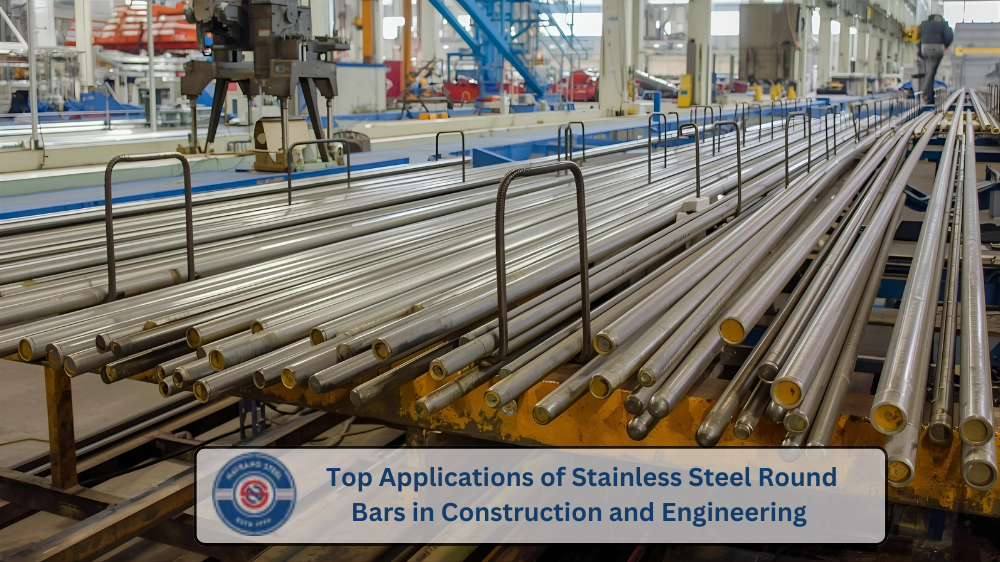
Stainless steel round bars are one of the most widely used materials in construction and engineering due to their exceptional strength, durability, and resistance to corrosion. Available in a variety of grades and sizes, these bars are designed to meet the demands of both structural and mechanical applications. With the growing emphasis on longevity, safety, and low maintenance in modern projects, stainless steel round bars have become an indispensable material in industries ranging from building construction, bridges, and railways to manufacturing, automotive, and aerospace engineering.
Understanding the applications, grades, and benefits of stainless steel round bars can help engineers, architects, and procurement professionals make informed choices for their projects.
Why Stainless Steel Round Bars Are Essential in Construction and Engineering
The popularity of stainless steel round bars in construction and engineering stems from several key properties:
- High Corrosion Resistance: Stainless steel naturally resists rust, oxidation, and chemical attack, making it ideal for structures exposed to moisture, chemicals, or marine environments.
- Mechanical Strength: These bars have high tensile and yield strength, ensuring stability in structural frameworks and machinery components.
- Versatility: Stainless steel round bars can be machined, forged, welded, or fabricated to suit diverse construction and engineering applications.
- Durability and Longevity: Reduced maintenance requirements and superior resistance to wear ensure that components last longer, lowering overall life-cycle costs.
- Aesthetic Appeal: Smooth, polished finishes make stainless steel round bars suitable for visible architectural elements without compromising functionality.
Because of these features, stainless steel round bars are extensively used in critical applications where reliability, strength, and corrosion resistance are essential.
Common Grades of Stainless Steel Round Bars
Different grades of stainless steel round bars are used depending on environmental exposure, load requirements, and specific engineering applications:
- 304 Stainless Steel Round Bars: Known for excellent corrosion resistance, this grade is widely used in general construction, indoor structures, and decorative applications.
- 316 Stainless Steel Round Bars: This grade offers superior resistance to chlorides, acids, and marine environments, making it ideal for coastal or chemical-intensive applications.
- 410 Stainless Steel Round Bars: This high-strength, martensitic stainless steel is used in engineering components requiring wear resistance, such as shafts and gears.
- Duplex Stainless Steel Bars: These bars combine high strength and corrosion resistance, commonly applied in offshore, oil and gas, and chemical engineering projects.
Selecting the appropriate grade is critical for optimizing performance, durability, and cost-effectiveness.
Applications in Construction
Stainless steel round bars play a pivotal role in modern construction, both structurally and decoratively:
Structural Reinforcements: These bars are used as tie rods, columns, beams, and support frameworks in buildings and bridges. Their high tensile strength ensures structural stability under heavy loads and harsh conditions.
Handrails, Balustrades, and Fencing: Stainless steel round bars are ideal for handrails, guardrails, staircases, and balconies. Their corrosion resistance and polished finish ensure safety, durability, and aesthetic appeal in public spaces.
Fasteners and Connectors: They are used to manufacture bolts, studs, and nuts for structural joints, ensuring a secure and long-lasting connection in construction frameworks.
Architectural Features: Stainless steel round bars are used in façades, decorative trims, and exposed frameworks, combining strength with modern design aesthetics.
Bridges and Infrastructure: In bridges, footbridges, and elevated structures, stainless steel bars are preferred for reinforcing load-bearing elements due to their ability to withstand environmental stress and corrosive conditions.
Applications in Engineering
Engineering applications demand materials with precision, strength, and wear resistance, which stainless steel round bars provide:
Machinery Components: Round bars are commonly used for shafts, axles, gears, and rollers, providing mechanical strength and durability.
Industrial Equipment: Valves, pressure vessels, heat exchangers, and pumps often use stainless steel bars for high-stress and high-corrosion applications.
Automotive and Aerospace Components: Stainless steel round bars are used in engine parts, drive shafts, and structural supports where high strength and corrosion resistance are critical.
Tooling and Dies: Stainless steel bars are employed to manufacture cutting tools, molds, dies, and industrial equipment components due to their hardness and wear resistance.
Energy and Power Plants: Used in turbine shafts, boilers, and piping systems where high temperature and corrosion resistance are essential.
Benefits of Using Stainless Steel Round Bars
Choosing stainless steel round bars for construction and engineering projects provides numerous advantages:
- Reduced Maintenance Costs: Resistance to rust and corrosion reduces repair and replacement frequency.
- Enhanced Durability: The high strength-to-weight ratio ensures stability and longevity under extreme stress.
- Design Flexibility: Can be fabricated into seamless, welded, or polished bars to suit structural, mechanical, or decorative needs.
- Cost-Effective Life Cycle: Though initial costs may be higher than carbon steel, the long service life and minimal maintenance make them cost-efficient.
- Environmental Resistance: Resistant to harsh weather, chemicals, and marine conditions.
Choosing the Right Stainless Steel Round Bar
Selecting the right grade and size depends on load requirements, environmental exposure, and intended application.
- For general construction and indoor applications, 304 stainless steel round bars are suitable.
- For marine, chemical, or highly corrosive environments, 316 stainless steel bars are preferred.
- For high-strength mechanical engineering parts, 410 stainless steel round bars are ideal.
- For offshore, oil & gas, and highly demanding environments, duplex stainless steel bars provide the best combination of strength and corrosion resistance.
Correct material selection ensures project reliability, longevity, and safety.
Conclusion
Stainless steel round bars are a cornerstone in both construction and engineering due to their strength, durability, corrosion resistance, and versatility. From structural frameworks, handrails, and fasteners to industrial machinery, automotive components, and energy systems, these bars meet a wide array of applications.
By selecting the appropriate grade, size, and finish, engineers and builders can ensure optimal performance, safety, and longevity for their projects. High-quality stainless steel round bars provide the confidence and reliability required to build durable, efficient, and aesthetically pleasing structures and machinery.
